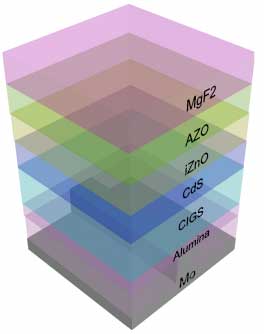| Oct 18, 2019 | |
Big improvements in thin-film solar cell efficiency now possible(Nanowerk News) Researchers at Penn State and Delaware have developed a theoretical method to improve the efficiency of thin-film solar cells by up to 33 percent (Applied Optics, "Efficiency enhancement of ultrathin CIGS solar cells by optimal bandgap grading."). |
|
| Flexible thin-film solar cells are needed to supply electrical power to fabrics, clothing, back packs and anywhere that a local autonomous power supply is required. | |
 |
|
| Schematic of a CIGS solar cell. (Image: Lakhtakia Lab/Penn State) | |
| Rooftop solar based on silicon has made solar energy cheap and readily available. But silicon is rigid and heavy, suitable for large-scale power production but not for portable power. Currently, flexible solar commands around 5 percent of the solar cell market. In order to increase the use of flexible solar it is important to increase the conversion efficiency from its current level of around 21 percent. By tweaking a couple of layers in the solar cell, the researchers believe they can increase efficiency to 27.8 percent. | |
| “Current CIGS cells have a homogenous semiconductor layer,” says Akhlesh Lakhtakia, Evan Pugh University Professor and Charles Godfrey Binder Endowed Professor of Engineering Science and Mechanics, Penn State. “We said, let us go with a nonhomogeneous layer designed to give us the maximum efficiency.” | |
| By varying the semiconductor bandgap on a gradient, they were able to improve the capture of solar energy and increase efficiency by a third. A second tweak involves including a rough reflective layer which helps to slow the recombination of electrons and their holes, again improving efficiency. | |
| In other work, the team has shown that they can increase the efficiency of another type of thin-film cell from 12 percent to 21 percent, an improvement of 80 percent. | |
| “This tells us the opportunity for significant improvement exists,” he says. | |
| Other opportunities have also arisen, including optimizing solar cells for interior lighting and for developing colored solar cells that can be incorporated into designs and clothing. |
| Source: Penn State Materials Research Institute | |
|
Subscribe to a free copy of one of our daily Nanowerk Newsletter Email Digests with a compilation of all of the day's news. |
